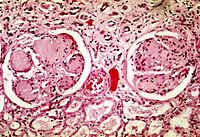
Photo from wikipedia
AIMS The roles of urinary albumin, eGFRcystatin (eGFRcys), and eGFRcreatinine (eGFRcre) in the progression of coronary artery calcification (CAC) remain unclear. Therefore, the present study investigated the relationship between kidney… Click to show full abstract
AIMS The roles of urinary albumin, eGFRcystatin (eGFRcys), and eGFRcreatinine (eGFRcre) in the progression of coronary artery calcification (CAC) remain unclear. Therefore, the present study investigated the relationship between kidney function and CAC progression. METHODS A total of 760 Japanese men aged 40-79 years were enrolled in this population-based study. Kidney function was measured using eGFRcre, eGFRcys, and the urine albumin-to-creatinine ratio. CAC scores were calculated using the Agatston method. CAC progression was defined as an annual increase of >10 Agatston units (AU) among men with 0<CAC<100 AU at baseline, that of >10% among those with CAC ≥ 100 AU, and any progression for those with CAC=0 at baseline. The relative risk (RR) of CAC progression based on kidney function was assessed using a robust Poisson regression model. RESULTS The mean follow-up period was 4.9 years. CAC progression was detected in 45.8% of participants. Positive associations between CAC progression and albuminuria (>30mg/g) (RR: 1.29; 1.09 to 1.53; p=0.004) and low eGFRcys (<60ml/min/1.73m2) (RR: 1.27; 1.05 to 1.53; p=0.012) remained significant after adjustments for age, the follow-up time, and computerized tomography type. Following further adjustments for hypertension, diabetes mellitus, dyslipidemia, C-reactive protein, and lifestyle factors, CAC progression was associated with albuminuria (RR: 1.20; 1.01 to 1.43; p=0.04) and low eGFRcys (RR: 1.19; 0.99 to 1.43; p=0.066), but not with eGFRcre. CONCLUSION CAC progression was associated with albuminuria; however, its relationship with eGFRcys was weakened by adjustments for risk factors.
Journal Title: Journal of atherosclerosis and thrombosis
Year Published: 2021
Link to full text (if available)
Share on Social Media: Sign Up to like & get
recommendations!